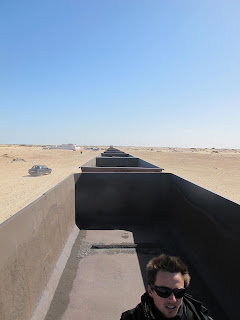We left Morocco and entered an active mine field. And I
don’t mean this in any metaphorical sense. The gutted, charred carcasses of old
vehicles were quite literal. We had entered the infamous 3km no-mans land
that exists between the Moroccan and Mauritanian border posts and it was an
unnerving place. The thin film of cloud bleached the sky and landscape alike
creating a Mad Max-like apocalyptic feel to it. What was distinctly
unapocalyptic about it, however, was the care-free herd of wild camels that
nonchalantly strutted in amongst these primitive explosives - blissfully
unaware that every two-toed footprint may be its last. We asked our taxi-driver
– who may or may not have been Ben Kingsley taking time off from making Santam
ads – to stop so that we might behold the frankly awesome spectacle of a camel being blown to smithereens. But he wasn’t keen. I think he had seen it all before.
So from our very first moment in Mauritania it became
apparent that the comfortable but somewhat unexciting journeys we had made
around Morocco were no more. The Mauritanian border official who processed our
paperwork hinted as much. After swatting away swarms of flies that seem to have
materialised out of nowhere the minute we left Morocco and chasing a
toothpaste-eating goat from the entrance to the hut, he finally attended to us.
As his official stamp hit the plush page of the passport – the point of no
return – he didn’t offer the usual immigration jargon of “Welcome”, “Enjoy your
trip” or even the stoney silence of bureaucrats who know they are, in fact,
your daddy. No, he looked us straight in the eye and, with no discernible tone
to his voice, ominously muttered the words “Good luck”. I don’t think people
skills are big in this neck of the desert.
We soon found out what he meant, though. Our first journey
within Mauritania – to the desert town of Atar – had no roads linking it to the
grimy coastal hovel of Nouadhibou. It did have a train though. Good news. At 2,3kms the
longest train on the planet, in fact. Better news. But it’s not designed to
carry humans. Not such good news. It is a train created exclusively to collect
vast quantities of iron ore, eviscerated from the bowels of the Sahara, and lug
it to the coast to be exported. Probably to Russia. They seem to like iron ore.
And it seems that they accept payment in the unlikely form of Soviet condensed
milk. Tins of which ply the shelves of every shop, household and dingy coffee
den. It seems the Cold War has found an unusual outlet in Africa in the form of
confectionary. Its unsurprising that it’s not produced locally as Mauritania
has no industrialisation to speak of, so all it can rely on to fill its sandy
coffers are its sparse natural resources consisting almost exclusively of iron
ore and fish. Tinned sardines can only do so much to stimulate a nation’s
economy so this ore forms the backbone of what pays the salaries of the vast armies of gendarmes manning the roadblocks. And
reserves of it are apparently dwindling fast. This was in no way apparent as we
found ourselves in an one of the thousands of open-air iron ore carriages,
hurtling through the Sahara towards the vast mines of the intimidatingly-named
Zouerat . We had imagined golden dunes slipping by, universes visible beyond
the untainted starry sky, man-love. What we got instead was iron ore dust which
not only blocked out all in its path but also managed to penetrate every bodily
orifice imaginable. We emerged after
thirteen gritty hours looking like the workers of Zouerat and feeling like one
of the camels of no-mans land. After they had stood on one of those mines.







No comments:
Post a Comment